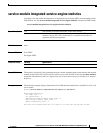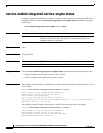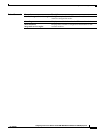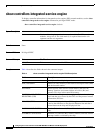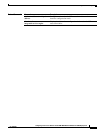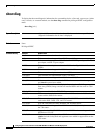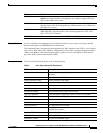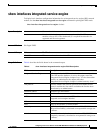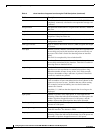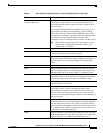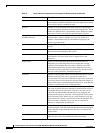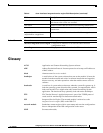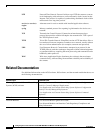
35
Configuring Cisco Access Routers and the NME-WAE Network Module for ACNS Deployments
OL-13140-02
show interfaces integrated-service-engine
5 minute input rate,
5 minute output rate
Average number of bits and packets transmitted per second in the
last 5 minutes. If the interface is not in promiscuous mode, it
senses network traffic that it sends and receives (rather than all
network traffic).
The 5-minute input and output rates should be used only as an
approximation of traffic per second during a given 5-minute
period. These rates are exponentially weighted averages with a
time constant of 5 minutes. A period of four time constants must
pass before the average will be within 2 percent of the
instantaneous rate of a uniform stream of traffic over that period.
Note The 5-minute period referenced in this output is a load
interval that is configurable under the interface. The
default value is 5 minutes.
packets input Total number of error-free packets received by the system.
bytes Total number of bytes, including data and MAC encapsulation, in
the error-free packets received by the system.
no buffer Number of received packets discarded because there was no
buffer space. Ignored Broadcast storms on Ethernet and bursts of
noise on serial lines are often responsible for no input buffer
events.
Received broadcasts Number of broadcasts received.
runts Number of packets that are discarded because they are smaller
than the minimum packet size of the medium. For instance, any
Ethernet packet that is less than 64 bytes is considered a runt.
giants Number of packets that are discarded because they exceed the
maximum packet size of the medium. For example, any Ethernet
packet that is greater than 1518 bytes is considered a giant.
throttles Number of times that the interface requested another interface
within the router to slow down.
input errors Errors that include runts, giants, no buffer, cyclic redundancy
check (CRC), frame, overrun, and ignored counts. Other
input-related errors can also cause the input errors count to be
increased, and some datagrams may have more than one error;
therefore, this sum may not balance with the sum of enumerated
input error counts.
CRC Errors created when the CRC generated by the originating LAN
station or far-end device does not match the checksum calculated
from the data received. On a LAN, such errors usually indicate
noise or transmission problems on the LAN interface or the LAN
bus. A high number of CRCs is usually the result of collisions or
a station that is transmitting bad data.
frame Number of packets received incorrectly that have a CRC error and
a non-integer number of octets. On a LAN, this error is usually the
result of collisions or a malfunctioning Ethernet device.
Table 6 show interfaces integrated-service-engine Field Descriptions (continued)
Field Description



